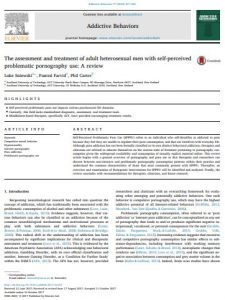Mental Health
The Assessment and Treatment of Adult Heterosexual Men with Self-Perceived Problematic Pornography Use
 Full Article Title: The Assessment and Treatment of Adult Heterosexual Men with Self-Perceived Problematic Pornography Use: A Review
Full Article Title: The Assessment and Treatment of Adult Heterosexual Men with Self-Perceived Problematic Pornography Use: A Review
Open Access: No
Highlights
• Self-perceived problematic porn use impacts various psychosocial life domains.
• Currently, this field lacks standardized diagnostic, assessment, and treatment tools.
• Mindfulness-based therapies, specifically ACT, have provided encouraging treatment results.
Abstract
Self-Perceived Problematic Porn Use (SPPPU) refers to an individual who self-identifies as addicted to porn because they feel they are unable to regulate their porn consumption, and that use interferes with everyday life. Although porn addiction has not been formally classified as its own distinct behavioral addiction, therapists and clinicians are advised to educate themselves on the current state of literature pertaining to pornography consumption given the widespread availability and consumption of sexually explicit material online. This review article begins with a general overview of pornography and porn use so that therapists and researchers can discern between non-intrusive and problematic pornography consumption patterns within their practice and understand the common characteristics of those that most commonly present with SPPPU. Thereafter, an overview and examination of therapeutic interventions for SPPPU will be identified and analysed. Finally, the review concludes with recommendations for therapists, clinicians, and future research.
